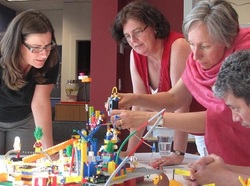Experimental semiotics and quantitative methods in interaction research

Signs and language are impressive tools for coordinating behavior and thought with others, enabling especially effective and flexible forms of social interaction, perspective-taking and joint action.
Adopting an experimental and quantitative perspective, the course will deal with the following topics:
Lecture 1: A dynamical approach to sign and language use
Lecture 2: The dynamics of dialogue
Lecture 3: Measuring coordination: An introduction to recurrence analysis
Lecture 4: Measuring coordination II: the case of dialogue
Lecture 5: Clinical Applications
Background and additional readings:
On experimental semiotics
On non-linear methods
On the dynamics of dialogue
On clinical aspects of dialogue
Adopting an experimental and quantitative perspective, the course will deal with the following topics:
- Experimental investigation of sign use in social interactions and social communities.
- Dialogue as a case study: how language is shaped and adapted in the course of a conversation, how this affects ongoing joint actions.
- Which methods can be used to quantify coordination, with an introduction to recurrence quantification analysis.
- Which are the clinical applications of these lines of research? What can linguistic and social interactive impairments tell us about dialogue?
Lecture 1: A dynamical approach to sign and language use
- Galantucci, B., Garrod, S., & Roberts, G. (2012). Experimental semiotics. Language and Linguistics Compass, 6(8), 477-493.
- Tylén, K., Fusaroli, R., Bundgaard, P. F., & Østergaard, S. (2013). Making sense together: A dynamical account of linguistic meaning-making. Semiotica, 2013(194), 39-62.
- Rączaszek–Leonardi, J. (2009). Symbols as constraints: the structuring role of dynamics and self-organization in natural language. Pragmatics and Cognition, 17:3, pp. 653-676.
Lecture 2: The dynamics of dialogue
- Pickering, M. J., & Garrod, S. (2004). Toward a mechanistic psychology of dialogue. Behavioral and brain sciences, 27(2), 169-189.
- Fusaroli, R., Rączaszek-Leonardi, J., & Tylén, K. (2013). Dialog as interpersonal synergy. New Ideas in Psychology.
Lecture 3: Measuring coordination: An introduction to recurrence analysis
- Richardson, D. C., Dale, R., & Shockley, K. (2008). Synchrony and swing in conversation: coordination, temporal dynamics, and communication. Embodied Communication in Humans and Machines, 75-93.
- Riley, M. A., Richardson, M. J., Shockley, K., & Ramenzoni, V. C. (2011). Interpersonal synergies. Frontiers in psychology, 2.
Lecture 4: Measuring coordination II: the case of dialogue
- Leonardi, G. (2012). The study of language and conversation with recurrence analysis methods. Psychology of Language and Communication, 16(2), 165-183.
- Fusaroli, R. & Tylén, K Individual behavior, interactive alignment or interpersonal synergy?, Working paper.
Lecture 5: Clinical Applications
- Goodwin, C. (2010). Constructing meaning through prosody in aphasia. Prosody in interaction, 23.
- Angus D, Watson B, Smith A, Gallois C, Wiles J (2012) Visualising Conversation Structure across Time: Insights into Effective Doctor-Patient Consultations. PLoS ONE 7(6).
- Fusaroli et al (2013) Clinical Voices, CogSci 2013 Proceedings.
Background and additional readings:
On experimental semiotics
- Fay, N., Garrod, S., & Roberts, L. (2008). The fitness and functionality of culturally evolved communication systems. Philosophical Transactions of the Royal Society B: Biological Sciences, 363(1509), 3553-3561.
- Galantucci, B. (2005). An experimental study of the emergence of human communication systems. Cognitive science, 29(5), 737-767.
- Galantucci, B., & Garrod, S. (2011). Experimental semiotics: a review. Frontiers in human neuroscience, 5.
- Garrod, S., Fay, N., Lee, J., Oberlander, J., & MacLeod, T. (2007). Foundations of representation: Where might graphical symbol systems come from?. Cognitive Science, 31(6), 961-987.
- Hasson, U., Ghazanfar, A. A., Galantucci, B., Garrod, S., & Keysers, C. (2012). Brain-to-brain coupling: a mechanism for creating and sharing a social world. Trends in cognitive sciences, 16(2), 114-121.
- Stolk, A., Verhagen, L., Schoffelen, J. M., Oostenveld, R., Blokpoel, M., Hagoort, P., ... & Toni, I. (2013). Neural mechanisms of communicative innovation. Proceedings of the National Academy of Sciences.
On non-linear methods
- Konvalinka, I., Xygalatas, D., Bulbulia, J., Schjødt, U., Jegindø, E. M., Wallot, S., ... & Roepstorff, A. (2011). Synchronized arousal between performers and related spectators in a fire-walking ritual. Proceedings of the National Academy of Sciences, 108(20), 8514-8519.
- Richardson, M. J., Dale, R., & Marsh, K. (2013). Complex dynamical systems in social and personality psychology: Theory, modeling and analysis. Handbook of Research Methods in Social and Personality Psychology.
- Van Orden, G. C. (Ed.). (2005). Tutorials in contemporary nonlinear methods for the behavioral sciences. National Science Foundation.
On the dynamics of dialogue
- Dale, R., Fusaroli, R., Duran, N., & Richardson, D. C. (2014). The self-organization of human interaction. Psychology of Learning and motivation, 59, 43-96.
- Fusaroli, R., Bahrami, B., Olsen, K., Roepstorff, A., Rees, G., Frith, C., & Tylén, K. (2012). Coming to terms quantifying the benefits of linguistic coordination. Psychological science, 23(8), 931-939.
- Fusaroli, R., & Tylén, K. (2012). Carving language for social coordination: A dynamical approach. Interaction studies, 13(1), 103-124.
- Louwerse, M. M., Dale, R., Bard, E. G., & Jeuniaux, P. (2012). Behavior matching in multimodal communication is synchronized. Cognitive science, 36(8), 1404-1426.
On clinical aspects of dialogue
- Lavelle M, Healey PGT, and McCabe R. Nonverbal behaviour during face-to-face social interaction in schizophrenia: A review, Journal of Nervous and Mental Disease
- Slocombe, K. E., Alvarez, I., Branigan, H. P., Jellema, T., Burnett, H. G., Fischer, A., ... & Levita, L. (2012). Linguistic Alignment in Adults with and Without Asperger’s Syndrome. Journal of autism and developmental disorders, 1-14.
- Marsh, K. L., Isenhower, R. W., Richardson, M. J., Helt, M., Verbalis, A. D., Schmidt, R. C., & Fein, D. (2013). Autism and social disconnection in interpersonal rocking. Frontiers in integrative neuroscience, 7.
